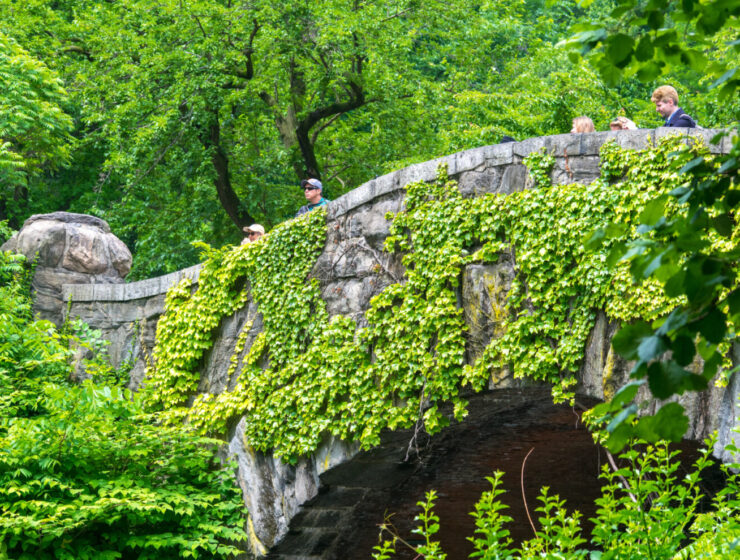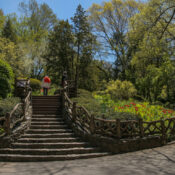One of the most distinctive ornamental features in the south end of Central Park, Pinebank Arch is an elegant cast-iron bridge that spans the bridle path.
Designed to be integrated with the landscape, it seems to emerge from rock outcrops on either end, and its lacy ironwork almost blends in with the surrounding foliage. The bridge is often photographed and is a popular spot from which to survey the surrounding landscapes and take photographs.
Central Park’s arches and bridges are an integral part of its circulation system. The Park’s designers, Frederick Law Olmsted and Calvert Vaux, created an intricate system of pedestrian paths, a bridle path, and carriage drives to allow visitors to experience the Park’s landscapes in a variety of ways. However, for this system to work safely and in a relatively small space, it had to limit interactions between potentially conflicting forms of traffic. The Park’s arches and bridges separate this traffic by carrying one form of transportation over another.
Between 1859 and 1866, 27 arches and bridges were built in Central Park. All were designed by Vaux—in some cases with the assistance of fellow architect Jacob Wrey Mould. Each one is unique, designed with various materials and decorative motifs and with careful consideration of its placement in the landscape. Over time, six arches and bridges were added and three were removed, bringing the total to 30 ornamental bridges and arches in the Park today. There are also additional bridges in the Park’s woodlands that are smaller, constructed with wood, and typically cross over streams.
Another key part of this circulation system are the transverse roads that allow City traffic to cross the Park. The transverse roads are sunken below the grade of the Park with bridges crossing over them. These bridges were designed as more utilitarian structures and weren’t intended to be seen—but they allow pedestrians and other traffic to seamlessly move through the Park. There are 13 transverse road bridges (one of which, Denesmouth, is also considered an ornamental bridge).






3 Comments
Id vim facilis ceteros percipit, altera phaedrum sea at, te alia novum praesent sit. Ne justo mazim delenit eam, pri ex brute interpretaris, invenire.
Praesent finibus congue euismod. Nullam scelerisque massa vel augue placerat, a tempor sem egestas. Curabitur placerat finibus lacus.
Ut enim ad minim veniam, quis nostrud exercitation ullamco laboris nisi ut aliquip ex ea commodo consequat. Duis aute irure dolor in reprehenderit.